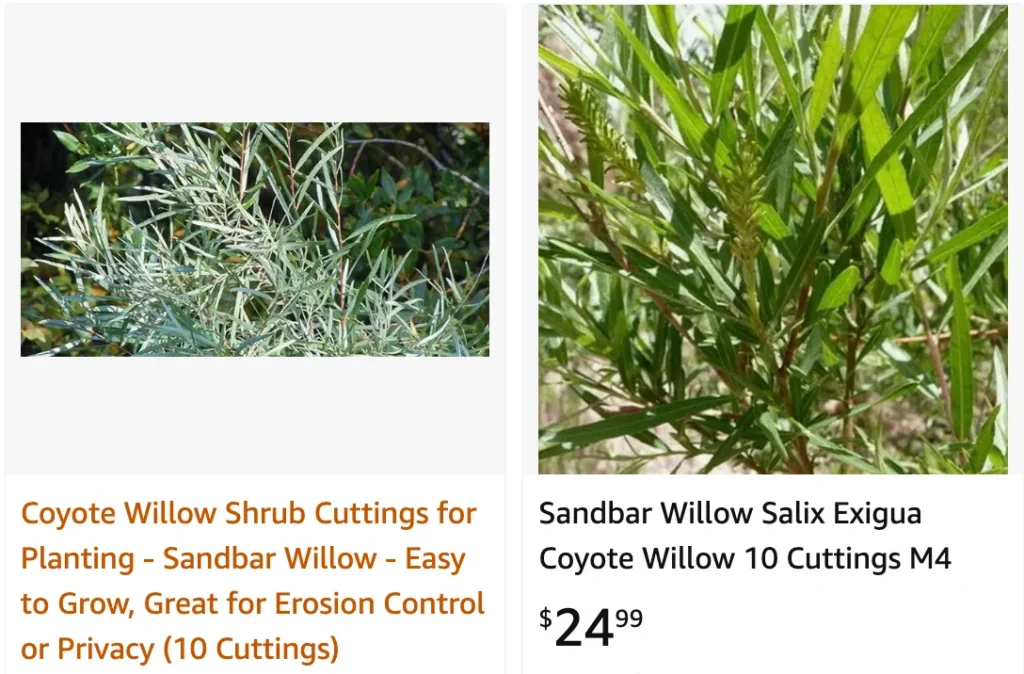
Embracing Nature’s Wonders: Sandbar Willow Unveiled
Salix Exigua, commonly known as Sandbar Willow, has been a constant companion in my exploration of nature’s marvels. Native to most of North America, this deciduous shrub graces landscapes from Alaska to New Brunswick and as far south as northern Mexico, with the exception of the southeast and far north regions. In my encounters with this fascinating plant, I’ve delved into its diverse subspecies, cultivation as an ornamental tree, and the myriad ways it intertwines with the ecology of its surroundings.
Witnessing the Beauty: A Closer Look at Salix Exigua
As I walk through nature reserves and wetland areas, the striking presence of Sandbar Willow never fails to captivate me. Standing tall at 13 to 23 feet, this shrub spreads through basal shoots, creating dense clonal colonies. The lanceolate leaves, 4 to 12 centimeters long, showcase a palette ranging from green to grayish, adorned with silky white hairs in their youth. The flowering spectacle occurs in late spring when yellow or white catkins emerge, creating a picturesque scene complemented by the subsequent appearance of capsules containing minute seeds embedded in shiny white silk.

Exploring Subspecies and Variants
My curiosity led me to discover the distinct characteristics of Salix Exigua through its subspecies and variants. In the western North America variant, leaves maintain a grayish hue throughout summer, featuring persistent silky hairs. On the contrary, the eastern and central North American variant experiences a seasonal transformation, with leaves usually losing hairs and turning green by summer. This diversity in foliage adds an extra layer of intrigue to my encounters with this remarkable willow.
Cultivation: Bringing Sandbar Willow into Gardens
Beyond the realms of natural habitats, Sandbar Willow has found its way into cultivation as an ornamental tree. The Royal Horticultural Society’s Award of Garden Merit in the UK recognizes its contribution to landscaping aesthetics. I’ve witnessed the graceful integration of Salix Exigua into gardens, where its upright form and moderate to fast growth rate make it a standout choice for those seeking both beauty and resilience.
A Symphony of Uses: Nurturing a Connection with Salix Exigua
From Branches to Medicine: Salix Exigua’s Multifaceted Utility
My journey with Salix Exigua extends beyond mere observation; it involves experiencing the cultural and utilitarian significance this willow holds for Native Americans. As I delved into its uses, I uncovered a tapestry of functionalities. The branches serve as flexible poles and building materials, while smaller twigs are transformed into intricately woven baskets. The bark becomes cord and string, and its medicinal properties are harnessed by the Zuni people for remedies like coughs and sore throats. These revelations not only deepen my appreciation for the plant but also highlight its integral role in indigenous traditions.
A Haven for Wildlife: Salix Exigua in Ecological Harmony
My interactions with Salix Exigua have unveiled its role as a haven for wildlife. The foliage becomes a grazing ground for livestock, showcasing the interconnectedness between this willow and the animal kingdom. The male flowers, abundant in pollen, offer sustenance to bees, reinforcing the crucial role it plays in pollination dynamics. Additionally, Salix Exigua stands as a larval host to several butterfly species, including the California hairstreak, Lorquin’s admiral, mourning cloak, sylvan hairstreak, and tiger swallowtail. These intricate ecological connections weave a rich tapestry of life around this unassuming shrub.
Nurturing Sandbar Willow: Insights into Cultivation and Propagation
Landscaping Marvel: Salix Exigua in Gardens
In my quest to understand the ideal conditions for cultivating Salix Exigua, I discovered its preference for full sun and tolerance to various soils, provided there is ample moisture. Its ability to thrive in wetland areas makes it a valuable addition to bogs, ponds, and bird gardens. The intertwining of Salix Exigua with other wetland-riparian trees and shrubs, such as maples, alders, and cottonwoods, creates a harmonious ecosystem.
Propagation Wisdom: Growing Sandbar Willow with Care
For those inclined to propagate Salix Exigua, my research unveiled some key insights. Fresh seeds, usually viable for only a few days, can be used without any special treatment. It’s essential not to cover or press the seeds into the medium, and the seedbed should be kept saturated for the initial month. Alternatively, the shrub is easily propagated from cuttings, offering a sustainable way to share the beauty and ecological benefits of this willow.
Personal Reflections: A Journey with Sandbar Willow
My Bond with Nature: Through the Lens of Salix Exigua
As I reflect on my experiences with Salix Exigua, I find a deep connection forged through the lens of nature. The willow’s resilience, adaptability, and intricate ecological relationships resonate with the broader lessons nature imparts. It serves as a reminder of the delicate balance within ecosystems and the profound impact a seemingly humble shrub can have on its surroundings.
A Call to Conservation: Protecting the Endangered
Discovering that Salix Exigua is considered threatened in Massachusetts and endangered in Connecticut, Maryland, and New Hampshire adds a sense of urgency to my appreciation. It prompts me to advocate for the conservation of this species and its habitats, recognizing the vital role it plays in maintaining biodiversity and supporting various forms of life.
Conclusion: A Tale Woven by Salix Exigua
In conclusion, my journey with Salix Exigua has been nothing short of a captivating tale. From its physical beauty to its cultural significance and ecological contributions, this sandbar willow has left an indelible mark on my understanding of nature. As I continue to explore and appreciate the world around me, Salix Exigua stands as a testament to the intricate dance of life, woven together by the threads of a resilient and remarkable shrub.



